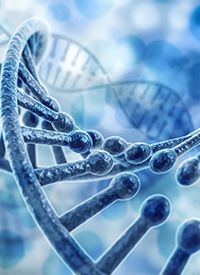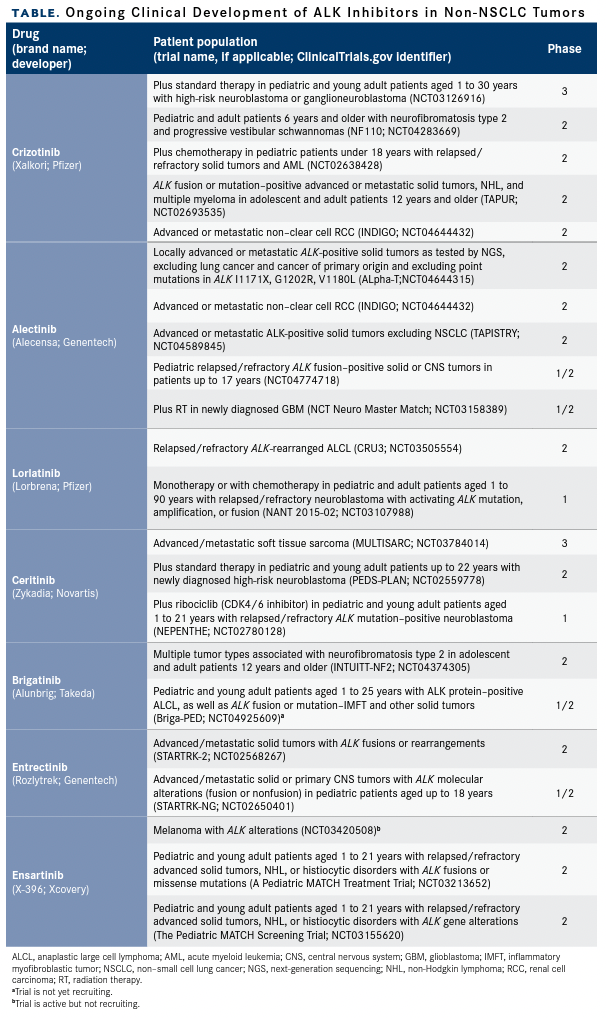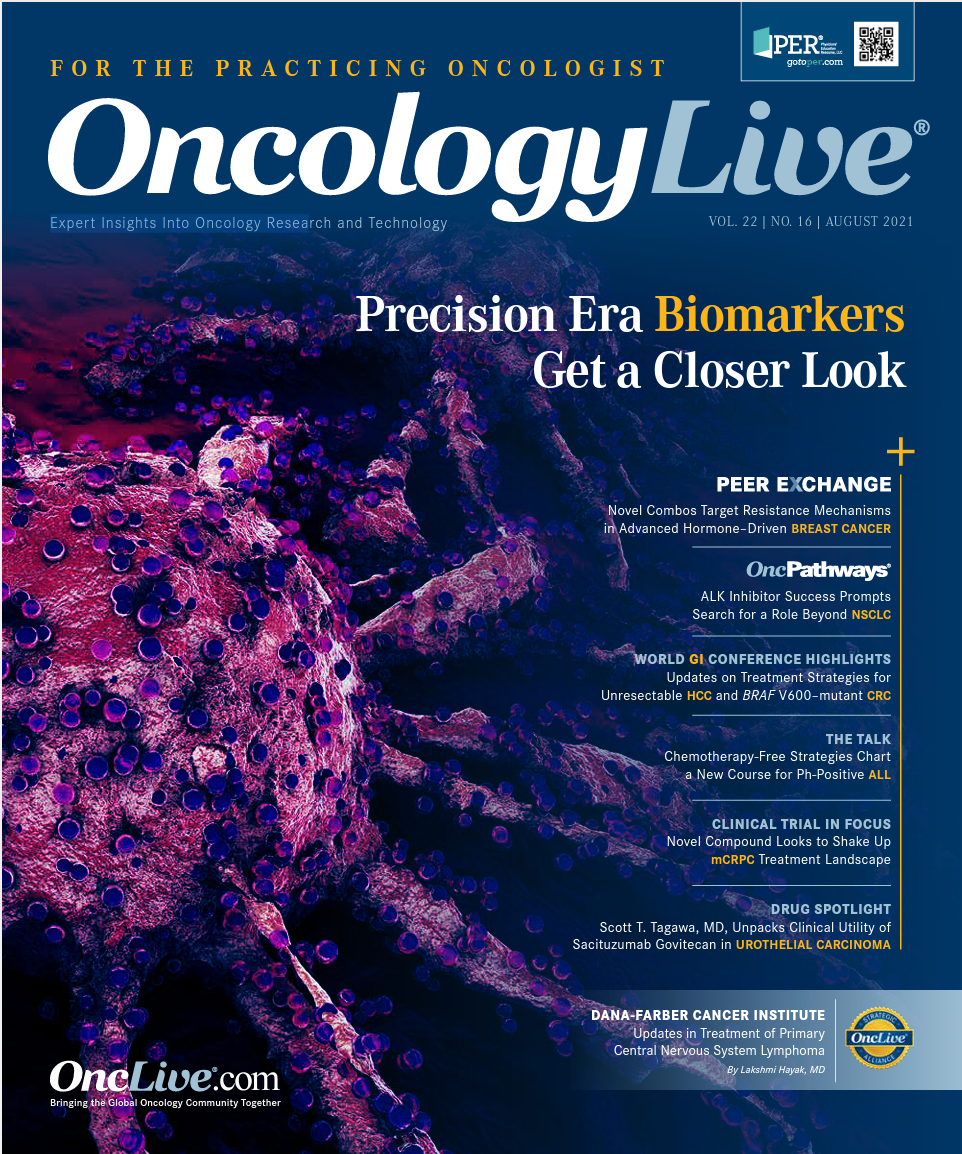Publication
Article
Oncology Live®
ALK Inhibitor Success Prompts Search for a Role Beyond NSCLC
Author(s):
The rapid development of novel agents directed at anaplastic lymphoma kinase gene fusions has emerged as one of the success stories of the targeted therapy era in non–small cell lung cancer

The rapid development of novel agents directed at anaplastic lymphoma kinase (ALK) gene fusions has emerged as one of the success stories of the targeted therapy era in non–small cell lung cancer (NSCLC).1,2 However, oncogenic activation of ALK, typically via fusions or other gene rearrangements, amplification, or activating point mutations (often accompanied by ALK protein expression), is seen in a range of other cancer types. This has prompted investigators to explore the question of whether ALK inhibitors can be effective in a broader landscape.3-5
The first indication for ALK inhibitors outside of NSCLC has come in anaplastic large cell lymphoma (ALCL), where ALK gene fusions are found in up to 90% of pediatric cases.4 In January 2021, the FDA approved crizotinib (Xalkori) for the treatment of pediatric and young adult patients with ALK-positive ALCL, making it the first ALK inhibitor approved for this patient population in the United States.6,7 The second-generation ALK inhibitor alectinib (Alecensa) is approved in Japan for this indication.8
Meanwhile, some neuroblastomas also are associated with activating ALK mutations,9,10 and crizotinib, alectinib, and the third-generation ALK inhibitor lorlatinib (Lorbrena) have demonstrated potential in this setting, with clinical trials ongoing.11-13
Findings from case reports suggest ALK inhibitor activity occurs across a spectrum of other cancer types, but the low frequency of ALK-positive tumors can make searching for these patients similar to looking for a needle in a haystack, as some commentators have observed. Investigators are using novel trial designs to evaluate ALK inhibitors in a range of solid tumor types (TABLE), but for the time being, widespread clinical validation of ALK inhibitors beyond NSCLC remains elusive.3
TABLE. Ongoing Clinical Development of ALK Inhibitors in Non-NSCLC Tumors

ALK in Diverse Tumors
ALK, a receptor tyrosine kinase, has been linked to cancer development since its identification in the 1990s. ALK was first described as the previously unknown gene juxtaposed with the nucleophosmin (NPM1) gene in a unique chromosomal rearrangement found in an ALCL cell line.14
Subsequently, ALK gene fusions, predominantly the NPM1-ALK fusion, have been identified in nearly all pediatric and approximately half of adult cases of ALCL, a rare form of non-Hodgkin lymphoma.4
Thanks to genome sequencing efforts, ALK gene fusions have been found across a wide range of cancer types, with multiple fusion partner genes.3,15 In lung cancer, the dominant ALK fusion is EML4-ALK, whereas approximately half of patients with inflammatory myofibroblastic tumors (IMFTs) display a TPM3/4-ALK fusion. Study results suggest that ALK fusions involving different partners vary in tumorigenic potential, but in each case the result is constitutive activation of ALK kinase.4 Other cancer types in which ALK fusions have been identified include renal, pancreatic, colorectal, breast, and thyroid cancers.15
Neuroblastoma, a childhood cancer arising in immature nerve cells that accounts for approximately 10% of pediatric cancer deaths, is characterized by a different kind of oncogenic ALK alteration. Germline gainof-function mutations in the ALK gene cause approximately half of all familial cases of neuroblastoma. ALK mutations also are observed in approximately 10% of patients with sporadic neuroblastoma.4,9,10
These mutations are typically found within the kinase domain, driving ligand-independent ALK activation. In neuroblastoma, the most common germline ALK mutations are R1275Q, R1192P, and G1128A. R1275Q also is one of the most common sporadic mutations in ALK, in addition to F1174L and F1245C. The frequency of ALK mutations has been shown to increase in patients at relapse, as secondary mutations lead to the emergence of resistance.4,5,9,10
In addition to fusions and mutations, ALK gene amplification and copy number gain are observed in many tumor types, including neuroblastoma, rhabdomyosarcoma, and esophageal cancer.4,5
ALK-Positive ALCL
ALK-positive ALCL has a better prognosis than ALK-negative disease and, in general, can be effectively treated in the front line with anthracycline-based chemotherapy. However, many patients experience disease relapse and have historically lacked effective treatment options.4,8
The FDA approved crizotinib for the treatment of patients with relapsed/refractory ALK-positive ALCL based on data from the phase 1/2 ADVL0912 study (NCT00939770), in which ALK positivity was assessed by immunohistochemistry (IHC) or fluorescence in situ hybridization (FISH) testing.6,16,17
Investigators enrolled patients between 1 and 21 years of age with relapsed/refractory solid tumors or ALCL. During phase 1 dose escalation, twice-daily doses up to 280 mg/m2 were well tolerated.16 Several phase 2 dose-expansion cohorts were undertaken, including in patients with ALK-positive ALCL who previously received at least 1 systemic therapy. These patients received twice-daily crizotinib at 280 mg/m2 (n = 20) or 165 mg/m2 (n = 6).17,18
An objective response rate (ORR) of 88% (95% CI, 71%-96%) was observed, which included complete responses (CRs) in 81% of patients. Responses continued for 6 months in 39% of patients and for 12 months in 22%. All patients treated at the dose of 280 mg/m2 experienced at least 1 grade 3 or higher adverse event (AE), which was considered possibly, probably, or definitely linked to crizotinib in 85% of cases, most commonly neutropenia.17,18
Alectinib was evaluated in a clinical trial involving relapsed/refractory ALK-positive ALCL in Japan. In February 2020, Chugai Pharmaceutical, the Japanese subsidiary of Roche, announced the approval of alec-tinib for this indication19 based on the demonstration of an ORR of 80% (90% CI, 56.2%-95.9%), including 6 CRs and 2 partial responses (PRs), among 10 patients enrolled in the phase 2 trial (UMIN-CTR unique trial No. UMIN000016991). One-year progres-sion-free (PFS), event-free survival, and overall survival (OS) rates were 58.3% (90% CI, 28.6-79.3%), 70.0% (90% CI, 39.6-87.2%), and 70.0% (90% CI, 39.6-87.2%), respectively. The most common AEs were diarrhea, upper respiratory infection, rash, and increased levels of alkaline phosphatase, whereas neutropenia was the most common AE of grade 3 and above.8
Broader Clinical Verification
In February 2021, investigators from the Children’s Oncology Group published results from the neuroblastoma cohort of the ADVL0912 trial. Among 20 patients with neuroblastoma who received twice-daily crizotinib at 280 mg/m2, the ORR was 15% (95% CI, 3.3%-34.3%), including 1 CR and 2 PRs. All responding patients displayed the R1275Q mutation.11
Lorlatinib is being studied in the phase 1 NANT 2015-02 trial (NCT03107988) in patients with ALK-positive neuroblas-toma. Preliminary results were recently reported; 32 patients with relapsed/refractory neuroblastoma with ALK mutations or amplification were treated at doses of 45, 60, 75, 95, or 115 mg/m2/day for patients 18 years and younger (pediatric cohort; n = 21) and at 100 or 150 mg/m2/day for patients older than 18 years (adult cohort; n = 11).13
The pediatric cohort had 1 CR, 1 PR, 3 minor responses, and 5 patients with stable disease (SD); in the adult cohort, there were 2 CRs, 3 PRs, 3 minor responses, and 2 cases of SD. The most common treatment-related AEs included weight gain, hypertriglyceridemia, and high cholesterol. Memory and concentration impairment of grade 1/2 severity were the most common neurocognitive toxicities in the adult cohort.13
The ADVL0912 trial also included 14 patients with ALK-positive IMFT. In this population, crizotinib was also found to be highly effective, with an ORR of 86% (95% CI, 57%-98%), including CRs in 36% of patients.18 The CREATE study (NCT01524926) enrolled multiple cohorts of patients with MET- or ALK-driven cancers to be treated with crizotinib. In a cohort of patients with ALK-positive IMFT (n = 12), the ORR was 50% (95% CI, 21.1%-78.9%). The disease control rate was 100% (95% CI, 73.5%-100%), and 1-year PFS and OS rates were 73.3% (95% CI, 37.9%-90.6%) and 81.8% (95% CI, 44.7%-95.1%), respectively. Common AEs included nausea, fatigue, blurred vision, vomiting, and diarrhea.20
In the phase 1b PROFILE 1013 trial (NCT01121588), crizotinib was studied in non-NSCLC tumors in which ALK gene translocation or inversion events were determined by IHC, FISH, or reverse transcriptase polymerase chain reaction or sequencing. Investigators observed objective responses in 53% of patients with lymphoma, including 8 CRs and 1 PR, and in 67% of patients with IMFT, including 1 CR and 5 PRs.21
PROFILE 1013 also enrolled 17 patients with a variety of other ALK-positive tumor types. Among these patients, the ORR was 12% and included 2 PRs in patients with colorectal and medullary thyroid cancer.21
Beyond this, evidence of the activity of ALK inhibitors in other cancer types or of the activity of other next-generation ALK inhibitors is limited largely to case reports for ceritinib (Zykadia) and preclinical activity for brigatinib (Alunbrig), although numerous clinical trials are ongoing, according to a search of ClinicalTrials.gov.
These case reports suggest potential activity of ALK inhibitors across a spectrum of ALK-positive cancers, including renal, breast, ovarian, prostate, and colorectal cancers.3,22,23 Notably, a recent study identified 7 patients with rare ALK-positive tumors who had been treated outside of clinical trials with either alectinib (n = 5) or crizotinib (n = 2) as initial therapy. The ORR for the initial therapy was 85.7% (95% CI, 44%-97%). There were 2 CRs and 2 PRs among the 5 patients receiving alectinib, and both of those receiving crizotinib experienced PRs. Tumor types included IMFT, histiocytosis, histiocytic sarcoma, osteosarcoma, and parotid adenocarcinoma.24
Because of the low frequency of ALK alterations and heterogeneity in the specific types of ALK alterations involved, investigators have found that conducting randomized clinical trials of ALK inhibitors in non-NSCLC tumors is extremely challenging. They have turned to basket and umbrella trial designs that enroll patients with ALK alterations irrespective of histology.3
Two such trial designs were highlighted at the 2021 American Society of Clinical Oncology Annual Meeting. In the phase 2 TAPISTRY trial (NCT04589845), patients with ALK fusion–positive non-NSCLC tumors are being enrolled to an alectinib treatment arm.25 The phase 2 ALpha-T trial (NCT04644315) is administering alectinib to adults with any locally advanced or metastatic solid tumor, excluding lung cancer and cancer of unknown primary, that harbors an ALK fusion or selected mutation (R1275Q, F1245C, F1174X). This trial is testing a novel decentralized design that permits enrollment regardless of location and allows most assessments to be performed at home by a mobile nurse.26
References
- Soda M, Choi YL, Enomoto M, et al. Identification of the transforming EML4-ALK fusion gene in non-small-cell lung cancer. Nature. 2007;448(7153):561-566. doi:10.1038/nature05945
- Lin JJ, Riely GJ, Shaw AT. Targeting ALK: precision medicine takes on drug resistance. Cancer Discov. 2017;7(2):137-155. doi:10.1158/2159-8290.CD-16-1123
- Salgia SK, Govindarajan A, Salgia R, Pal SK. ALK-directed therapy in non-NSCLC malignancies: are we ready? JCO Precision Oncology. 2021;(5):767-770. doi:10.1200/PO.21.00078
- Holla VR, Elamin YY, Bailey AM, et al. ALK: a tyrosine kinase target for cancer therapy. Cold Spring Harb Mol Case Stud. 2017;3(1):a001115. doi:10.1101/mcs.a001115
- Palmirotta R, Quaresmini D, Lovero D, Silvestris F. ALK gene alterations in cancer: biological aspects and therapeutic implications. Pharmacogenomics. 2017;18(3):277-292. doi:10.2217/pgs-2016-0166
- FDA approves crizotinib for children and young adults with relapsed or refractory, systemic anaplastic large cell lymphoma. FDA. Updated January 15, 2021. Accessed July 1, 2021. https://www.fda.gov/drugs/resources-information-approved-drugs/fda-approves-crizotinib-children-and-young-adults-relapsed-or-refractory-systemic-anaplastic-large
- Pfizer’s Xalkori (crizotinib) approved by FDA for ALK-positive anaplastic large cell lymphoma in children and young adults. News release. Pfizer Inc; January 14, 2021. Accessed August 3, 2021. https://bit.ly/3s3R7Z7
- Fukano R, Mori T, Sekimizu M, et al. Alectinib for relapsed or refractory anaplastic lymphoma kinase‐positive anaplastic large cell lymphoma: an open‐label phase II trial. Cancer Sci. 2020;111(12):4540-4547. doi:10.1111/cas.14671
- Pacenta HL, Macy ME. Entrectinib and other ALK/TRK inhibitors for the treatment of neuroblastoma. Drug Des Devel Ther. 2018;12:3549-3561. doi:10.2147/DDDT.S147384
- Umapathy G, Mendoza-Garcia P, Hallberg B, Palmer RH. Targeting anaplastic lymphoma kinase in neuroblastoma. APMIS. 2019;127(5):288-302. doi:10.1111/apm.12940
- Foster JH, Voss SD, Hall DC, et al. Activity of crizotinib in patients with ALK-aberrant relapsed/refractory Neuroblastoma: a Children’s Oncology Group Study (ADVL0912). Clin Cancer Res. 2021;27(13):3543-3548. doi:10.1158/1078-0432.CCR-20-4224
- Heath JA, Campbell MA, Thomas A, Solomon B. Good clinical response to alectinib, a second generation ALK inhibitor, in refractory neuroblastoma. Pediatr Blood Cancer. 2018;65(7):e27055. doi:10.1002/pbc.27055
- Goldsmith KC, Kayser K, Groshen SG, et al. Phase I trial of lorlatinib in patients with ALK-driven refractory or relapsed neuroblastoma: a New Approaches to Neuroblastoma Consortium study. JClin Oncol. 2020;38(suppl 15):10504. doi:10.1200/JCO.2020.38.15_suppl.10504
- Morris SW, Kirstein MN, Valentine MB, et al. Fusion of a kinase gene, ALK, to a nucleolar protein gene, NPM, in non-Hodgkin’s lymphoma. Science. 1994;263(5151):1281-1284. doi:10.1126/science.8122112
- ALK fusion. My Cancer Genome. Accessed June 29, 2021. https://bit.ly/3frNua0
- Mossé YP, Lim MS, Voss SD, et al. Safety and activity of crizotinib for paediatric patients with refractory solid tumours or anaplastic large-cell lymphoma: a Children’s Oncology Group phase 1 consortium study. Lancet Oncol. 2013;14(6):472-480. doi:10.1016/S1470-2045(13)70095-0
- Xalkori. Prescribing information.Pfizer; 2021. Accessed July 1, 2021. https://www.accessdata.fda.gov/drugsatfda_docs/label/2021/202570s030lbl.pdf
- Mossé YP, Voss SD, Lim MS, et al. Targeting ALK with crizotinib in pediatric anaplastic large cell lymphoma and inflammatory myofibroblastic tumor: a Children’s Oncology Group study. J Clin Oncol. 2017;35(28):3215-3221. doi:10.1200/JCO.2017.73.4830
- Chugai obtains approval for additional indication of Alecensa for recurrent or refractory ALK fusion gene-positive anaplastic large cell lymphoma. News release. Chugai Pharmaceutical Co, Ltd.February 21, 2020. Accessed July 1, 2021. https://www.chugai-pharm.co.jp/english/news/detail/20200221160002_704.html
- Schöffski P, Sufliarsky J, Gelderblom H, et al. Crizotinib in patients with advanced, inoperable inflammatory myofibroblastic tumours with and without anaplastic lymphoma kinase gene alterations (European Organisation for Research and Treatment of Cancer 90101 CREATE): a multicentre, single-drug, prospective, non-randomised phase 2 trial. Lancet Respir Med. 2018;6(6):431-441. doi:10.1016/S2213-2600(18)30116-4
- Gambacorti‐Passerini C, Orlov S, Zhang L, et al. Long‐term effects of crizotinib in ALK‐positive tumors (excluding NSCLC): a phase 1b open‐label study. Am J Hematol. 2018;93(5):607-614. doi:10.1002/ajh.25043
- He X, Jiao XD, Liu K, et al. Clinical responses to crizotinib, alectinib, and lorlatinib in a metastatic colorectal carcinoma patient with ALK gene rearrangement: a case report. JCO Precis Oncol. 2021;5:PO.20.00534. doi:10.1200/PO.20.00534
- Hsiao SY, He HL, Weng TS, et al. Colorectal cancer with EML4-ALK fusion gene response to alectinib: a case report and review of the literature. Case Rep Oncol. 2021;14(1):232-238. doi:10.1159/000511069
- Takeyasu Y, Okuma HS, Kojima Y, et al. Impact of ALK inhibitors in patients with ALK-rearranged nonlung solid tumors. JCO Precis Oncol. 2021;(5):756-766. doi:10.1200/PO.20.00383
- Drilon AE, Liu H, Wu F, et al. Tumor-agnostic precision immuno-oncology and somatic targeting rationale for you (TAPISTRY): a novel platform umbrella trial. J Clin Oncol. 2021;39(suppl 15):TPS3154. doi:10.1200/JCO.2021.39.15_suppl.TPS3154
- Kurzrock R, MacKenzie AR, Jurdi AA, et al. Alpha-T: an innovative decentralized (home-based) phase 2 trial of alectinib in ALK-positive (ALK+) solid tumors in a histology-agnostic setting. J Clin Oncol. 2021;39(suppl 15):TPS3155. doi:10.1200/JCO.2021.39.15_suppl.TPS3155







%20u.jpg?fit=crop&auto=format)

%20(2)%201-Recovered-Recovered-Recovered-Recovered-Recovered-Recovered-Recovered-Recovered-Recovered-Recovered-Recovered-Recovered-Recovered-Recovered-Recovered-Recovered-Recovered-Recovered-Recovered.jpg?fit=crop&auto=format)
%20(2)%201-Recovered-Recovered-Recovered-Recovered-Recovered-Recovered-Recovered-Recovered-Recovered-Recovered-Recovered-Recovered-Recovered-Recovered-Recovered-Recovered-Recovered-Recovered-Recovered.jpg?fit=crop&auto=format)